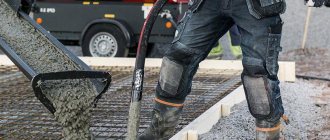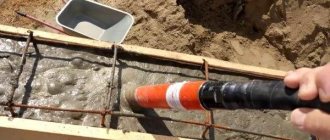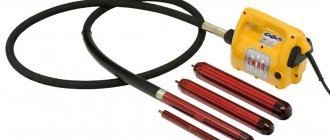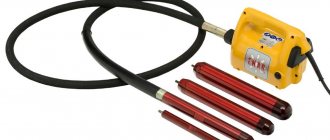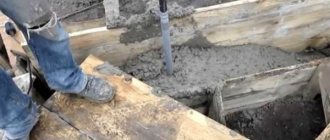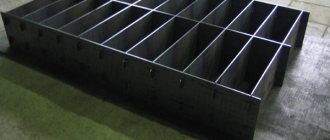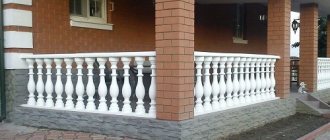In construction, when constructing foundations or monolithic walls with high-quality concrete, it is necessary to lay it without voids. For this purpose, special mechanisms have been created, called concrete compactors or vibrators. According to the principle of operation of the drive, there are 3 types of design:
- pneumatic,
- electrical and
- internal combustion engines (ICE).
According to the transmission of vibration to the solution - deep and surface.
Pneumatic units
There are two types: working on the principle of a pneumatic hammer and rotary turbines. In the first case, the working element receives vibration from the impacts of the driving hammer on the strikers. In the second, a flexible drive is attached to the tip of the rotor, which is connected to the club. The rotor receives rotation from the compressed air created by the compressor.
Electrical
in turn, they are divided into stationary and portable. Stationary ones are produced driven by electric motors, which are installed on platforms or skids and have a limited ability to move. The motors are mounted on stands and remain motionless when the vibrator is operating. Portable (manual) driven by electric drills or hammer drills.
Internal combustion engines (ICE).
When driven by an internal combustion engine, the flexible shaft receives rotation from the clutch through a mechanical connection to the output shaft.
Flexible drive of the working body (club)
For this purpose, the industry produces an attachment - a concrete vibrator for a drill at a low price, which is available in household and professional versions. Vibrators produced for professional use: have a specific design depending on the type of work and drive power. Household: for simple home work on pouring concrete floors or grillage foundations. The article will consider only household devices for compacting concrete mixtures
Deep vibrator: description, scope of application, device
Deep vibrators for cement mortar are specific equipment for construction work related to the compaction of various structures made of concrete or reinforced concrete. Such devices significantly improve the quality of the mortar, facilitate the construction of monolithic structures, and reduce running costs and the construction time of the building.
Device Description
When pouring concrete into a foundation, regardless of the method chosen, it is saturated with a large amount of air and this process is further enhanced if the solution is dry enough. There are many voids left inside the base, which significantly affect the strength characteristics of the foundation and its service life. Previously, they used the manual “bayonet” method, but it was not effective enough. An electric vibrator creates high-frequency vibrations that help the cement mixture “get rid” of excess air and moisture.
A deep vibrator helps remove excess air and moisture from the concrete solution
Concrete acquires a uniform consistency, fluidity, and completely fills the entire form, preventing the formation of voids that affect the strength characteristics of the entire building structure in the future.
The principle of operation of the vibrator is to destroy the adhesion between the smallest elements of the concrete solution, during which voids and air bubbles are completely removed.
But do not forget about the inevitable shrinkage of concrete during its hardening, which can lead to the appearance of cracks that are dangerous to the structure.
Even low-quality concrete, after treatment with a vibrator, acquires the required degree of density and fluidity.
The concrete vibrator can be equipped with attachments of various diameters
Vibrators based on the vibration transmission method can be:
- deep - to create a compaction of the solution, the working part of the device is lowered into concrete poured from a concrete mixer into the formwork;
- Vibrating presses - used for constructing floors and interior ceilings;
- Vibrating presses for external work - installed on the formwork of reinforced concrete structures of vertical structures.
According to the method of vibration transmission, vibrators are deep, external and surface
Scope of application of the deep vibrator
Such devices are used in various fields of construction for installation, casting and construction of concrete and reinforced concrete structures. It is also used to fill strip, columnar, pile, screw, slab, shallow foundations, as well as monolithic columns and floor slabs.
During operation, the deep vibrator should not touch either the formwork or the reinforcement cage
Device design
The deep vibrator has three main parts in its design:
- a drive that drives the vibration device;
- flexible shaft with protective pad made of durable rubber;
- the tip, which is a vibrating mace.
The vibrator works in this way: the vibrating attachment creates certain vibrations in the liquid concrete solution. The mass flows smoothly over the established shape, creating a homogeneous monolithic surface. Thanks to the forward movements of the device, air bubbles disappear and voids filled with water are removed. As a result, the degree of frost resistance and water resistance of the entire structure increases. The adhesion of metal reinforcement to hardened concrete improves.
Vibrator characteristics:
- The vibrator electric motor can have a power of 1 kW or more with single or three-phase power.
- The bendable transfer shaft varies in length from 1 to 7 meters.
- The ends are provided with durable rubber elements between the motor mount and the vibrating tip.
- The working vibration part of the device can have a cylindrical shape or taper downward. The first is used with standard solution density, and the second with increased density.
- The tool may include several vibrating attachments, clubs Ø 25–80 mm and two or three bayonets.
- The design of the device consists of a housing made of a piece of stainless pipe, in which a metal shaft with a displaced center of gravity is mounted on roller-type bearings. During rotation, the device creates vibration vibrations of the required frequency, which depends on the speed of the motor.
- Immersion vibrators make from 10,000 to 20,000 rpm.
- The shaft is protected on top by a waterproof film made of polymer material.
The low weight of the vibrator allows one person to operate it. But if the shaft is more than one and a half meters long, then two craftsmen are involved in the work.
The diameter of the mace tip is selected depending on the density of reinforcement laying
Advantages of deep vibrators:
- Capable of compacting concrete that contains a large percentage of water. This allows you to increase the strength of the solution, increase its water resistance and resistance to negative temperatures.
- They improve the adhesion of concrete to reinforcement and ensure a tight fit around the seams.
- The classic instrument produces vibration vibrations with a frequency of 12 to 20 thousand rpm.
- Portable portable vibrators have a flexible shaft and a commutator electric drive. They have a low price, but a minimum resource to ensure a large volume of work.
- High-frequency vibrators are the most productive and produce special vibration vibrations.
Purpose
Even a solution thoroughly swirled in a stirrer cannot be 100% homogeneous. In theory, an uncured monolith is a “skeleton” of crushed stone, evenly covered with a wet cement-sand mixture. In reality, the contents of the formwork (form) include:
RECOMMENDED ON THE TOPIC
- Penetrating waterproofing for concrete
- How to choose impregnation for concrete
- air bubbles;
- water unbound with cement;
- undistributed aggregate or additive particles.
The risk of stratification and airing of the mortar increases with a long time interval between mixing and installation, incorrect pouring (from a great height or in thick layers) or transportation.
Liquid and air “pockets” impair the adhesion of the crushed stone frame to the binder. Having gained strength, uncompacted concrete quickly cracks and crumbles.
To achieve uniformity when pouring into formwork, the concrete solution must be fluid (plastic). At the same time, the correct proportions of heavy concrete exclude a consistency convenient for laying. The use of a deep vibrator for pouring concrete can temporarily increase the fluidity of concrete and prevent the mixture from separating.
After the “correct” vibration compaction:
- the volume of concrete poured into the formwork is reduced by a third - due to the removal of gas and liquid sinks, compaction of sand and crushed stone;
- Cement laitance and fine sand fractions float to the top, the surface becomes smooth and glossy.
During hardening, the “vibrated” monolith reaches high density and maximum (for the design grade) strength.
DIY vibrator from a hammer drill
It is much easier to make such a device from a hammer drill. And for this you will only need: the tool itself, a piece of iron rod and a thick round plate.
The power of the tool must be at least 1.5 kW. Then it will not overheat during operation for a long time. The length of the bending rod should be such that it rests against the bottom of the formwork, where the concrete solution is poured.
- We process one side of the nozzle for the tail part, which can be clamped into the hammer drill chuck. And to the second we weld a metal plate about 50–70 mm in diameter.
From a construction hammer you can make the simplest design of a concrete vibrator - Such a pike device will ensure the combined effect of vibration of the working part of the tool with an impact moment on the formwork itself, without its destruction. In the process of vibration of the formwork walls, the efficiency of removing air masses from the cement mortar increases significantly. Such work is carried out using the “bayonet with rebound” method over the entire surface of the structure element being compacted. Each formwork point can be processed within 3 minutes. A deep vibrator made from a perforator is excellent for construction work in impact mode if it affects the formwork elements from the outside.
When using a deep-hole vibrator based on a hammer drill, the concrete mixture is distributed as evenly as possible
Video: deep vibrator from a hammer drill at home
By drive type
The engine is one of the main components of the vibrator.
Based on the type of drive, vibrators are distinguished:
Electromechanical.
Tied to the electrical network - single-phase (220 V) or three-phase network (380) - they have limited mobility. 220 V manual concrete vibrators do not require any special conditions, but do not provide much power. Models with a three-phase motor are more powerful, but heavier and more difficult to connect;
Compact submersible vibratory compactors are mobile - they are battery-powered (often powered from the mains is also provided). Disadvantages - limited operating time by the battery capacity and low power. Regardless of the price, compact models are intended for domestic use and do not involve processing large volumes of concrete.
Based on an internal combustion engine - gasoline or diesel.
The vibrators do not depend on the electrical network and have a power of up to 4 kW - this is enough for vibration processing of large-volume concrete masses. Disadvantages - large dimensions and weight, difficulty of maintenance.
There are portable models of gasoline vibrators for concrete. They are mobile - the engine fits in a backpack. However, they are more expensive than stationary ones, and the power usually does not exceed 2 kW.
Pneumatic.
The oscillatory force is created by supplying a stream of compressed air from the compressor. Pneumatic vibrators are used in industrial conditions - they have a long service life, are explosion- and electrically safe, do not require complex maintenance, and can operate in humid and dusty conditions. The main area of application is the production of reinforced concrete products.
Based on power, we can conditionally distinguish vibrators:
- household - up to 2 kW. These are stationary or more convenient (and expensive) portable models - working with them does not require special knowledge and experience;
- professional – up to 4 kW. Heavy and, as a rule, stationary models, the maintenance of which requires special skills. Such vibrators are used for laying concrete in multi-story and industrial construction, and in the production of reinforced concrete.
